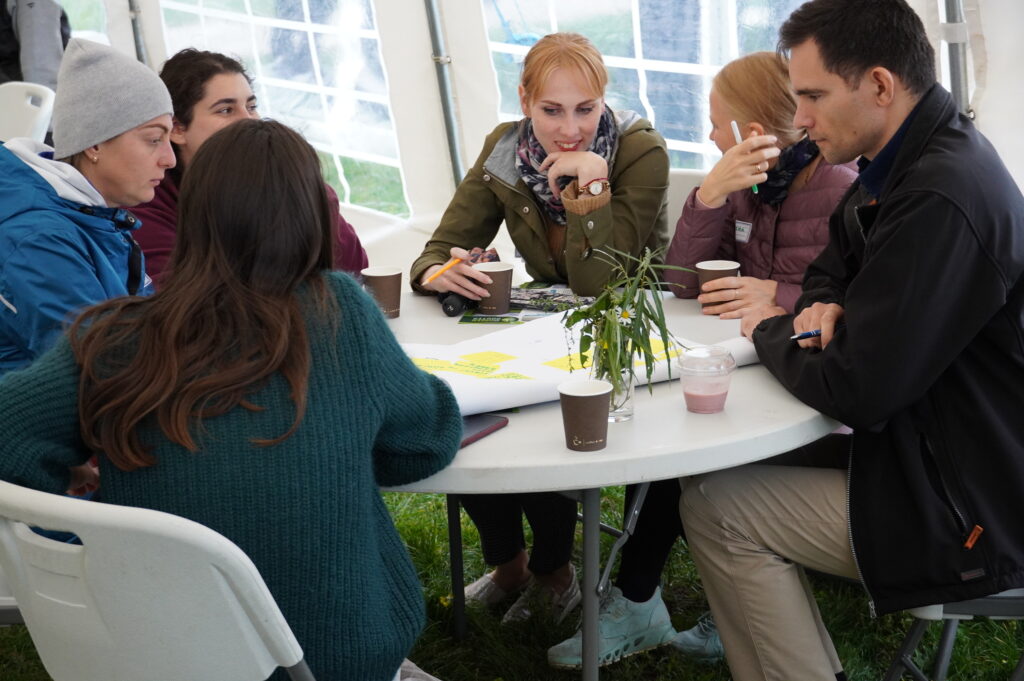Participatory green area planning with a diverse citizen group

Introduction
Project GoGreenRoutes is funded by the Horizon 2020 Innovation Action programme, which is evaluating different green and cultural solutions for Vormsi Park. The aim is to maintain and diversify the park to make it an accessible and pleasant place for leisure for all residents in the area. The area is densely populated with high rise housing. A majority of the population is Russian-speaking. The activities organised seek to increase environmental awareness, create an educational learning environment and promote healthy lifestyles. The project promotes cooperation and a sense of community by developing green space with local people, educational institutions and other regional organisations. Various environmental and welfare professionals have been involved in meeting site-specific needs and producing a well-designed solution.
Description of practice
Process:
● Preparatory work and a brainstorming event to map values, gaps and issues.
● Further planning to adapt the mapped ideas into concrete plans for implementation as pilot projects.
● Surveys carried out and quantitative data collected and analysed on meteorology, biodiversity, geological conditions, sociology, and so on.
● The results will be scaled-up to help address the future of the city.
● During the process, public consultations are being held both on-site and online.
● Following evaluation of the pilot, the results will be applied to create nature-based solutions in the Vormsi green area.
● Future project activities will depend on citizen feedback.
● Future events might include organising an environmental-themed orienteering game in the park with the help of youth centres and local schools; building a terrace on the school’s foundations with the help of spatial planning experts and launching a pop-up café in cooperation with the student council; and maintaining the existing fruit trees and planting additional berry bushes with the residents.
Who is involved
Involvement in the project is divided into four themes and thus involves the following stakeholders:
● Environment: Tallinn Strategic Management Office and its Competence Centre for Spatial Planning, and Green Revolution Section, Tallinn Urban Environment and Public Works Department (Environmental Protection and Management Division and Landscaping Division), Tallinn Botanic Garden, non-governmental organisations (MTÜ Rohelinn and MTÜ Lasnaidee)
● Welfare: Tallinn Welfare and Health Care Department
● Community: Lasnamäe city district, Lasnamäe youth council, apartment associations, Lasnamäe youth centre, Tallinn Education Department, local schools and kindergartens, NGOs (MTÜ Rohelinn and MTÜ Lasnaidee, Noorteklubi Active MTÜ) and residents
● Research: Tallinn University is helping with the data analysis
Promotion and communication
Events and results are communicated using an email list of all the people involved. The GoGreenRoutes webpage and the Facebook group for Vormsi Park are also used for communication. Communication is mostly carried out by a communication specialist at the Competence Centre of International Projects. Lasnamäe City District helps by sending communications to its residents. Information on the whole project can be found on the GoGreenRoutes Instagram page.
Requirements
● Resources: Human resources, finance
● Digital tools: Miro, Microsoft Teams
● Skills: Various means of communication, content translation, competent Russian and English language proficiency and translation, design skills
Time commitment
The project itself will take place on September 2020–August 2024. Most of the preparatory work took place in 2021 and some pilot projects are taking place in 2022. Over the next two years, the results from the pilot projects will be analysed and nature-based solutions devised based on those results.
| Level of participation |
|
| Urban planning challenge(s) tackled | Governance and institutional factors
Stakeholder engagement
Knowledge and skills
|
Lessons learned
● Communicating in three languages (Estonian, English and Russian) is a challenge and increases the workload.
● The idea-gathering event improved the initial ideas on proceeding with the project.
● Covid-19 led some meetings to be held online but most of the public consultations could be organised on-site in an open-air environment if proper health measures were taken.
Outcomes
● The pilot project involving residents in planning nature-based solutions/Green Infrastructure in Lasnamäe is considered successful thus far.
● The involvement process is very long-term and qualitative. The project experts are making sure that all the people involved have an opportunity to express their opinion on the area and are invited to public consultations.
● After the first gathering, among the ideas for the Vormsi Park area were: nature and health trails with different themes and routes, maintenance of the orchard, creating resting places for the older generation, and organising different cultural programmes and sports activities for all age groups.
Read more
GoGreenRoutes project page for Tallinn https://www.tallinn.ee/en/gogreenroutes
International GoGreenRoutes web page https://gogreenroutes.eu/







